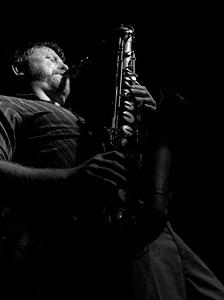April 14, 2010
When visiting professor of music and saxophonist Jason Robinson takes the stage at Buckley Recital Hall for a concert with pianist Myra Melford April 25, he’ll have one very important issue on his mind that most musicians usually don’t: whether or not his Web stream will drop.
He and Melford—who will play that evening on the West Coast from the University of California Berkeley’s Center for New Music and Audio Technologies—will perform together in a real-time, transcontinental concert using a high-speed Internet connection.
 |
The artist and live audience at each location will hear music from the other via Web streams piped into speakers at the venues. The show will also be Webcast from the Amherst music department Web site starting at 8 p.m. EST.
The gig is just another foray into the world of experimental music for Robinson, a jazz musician and scholar who has made a career of combining technology and his art. The April 25 event will be his second “multi-site networked concert” (MSNC) at Amherst since he joined the faculty in 2008. It is also part of the Faultlines Festival: Mapping Jazz in the 21st Century, a series of concerts, workshops, lectures and panel discussions that Robinson has coordinated during his two years at the college.
“I’m especially excited for this show because we’ll be using emergent, cutting-edge software to enable nearly simultaneous long-distance performing—something many of us only daydreamed about a few years ago,” he said recently. “I’m eager to see how things work out this time around.”
According to Robinson, the idea behind MSNCs is nothing new; musicians started toying with the notion of having performers playing together but from different locations about a half a century ago.
“These kinds of concerts were happening as early as the 1950s and ’60s using methods that were obviously a lot more primitive,” he explained. “In the 1980s and ’90s, they really began to take off. I’ve heard of several concerts in New York where one performer played into a receiver in a phonebooth somewhere in the city, and his or her music was pumped into a venue using a microphone set up next to a phone on the other end.”
The technology has changed since then, he said, but the concept is the same. “Now we’re using [opensource software] Jacktrip and the Internet instead of phonelines.”
That would be Internet2, to be exact. The bandwidth of the network is large enough to enable that “nearly simultaneous” delivery of audio for concerts. “Nearly,” however, is the key word.
“There’s a slight latency issue, a delay,” explained Robinson. “It poses certain challenges in the music. They aren’t necessarily insurmountable challenges, but interesting challenges from a compositional and improvisational point of view. My job as a composer is to figure out ways to use the delay to my advantage in the music.”
The April 25 concert will also feature some musical improvisation, adding another layer of complexity to an already challenging performance.
Robinson, though, is a veteran of such gigs, having participated in the first of several MSNCs in 1998. During that concert, he played from a stage in San Diego while music from his collaborators was piped in from sites in Vancouver, New York, Austria and Australia. The delay for that show was huge—two seconds.
Since then, the technology used in MSNCs has shortened musical latency to a fraction of a second, and Robinson has relished experimenting with it. He and a pair of California-based collaborators at his last MSNC in April 2009, for example, accounted for that imperfect alignment of the music at times during their show and hid the delays. At other points, they played up the latency. (Listen to an excerpt from one piece Robinson composed for that concert, “Vicissitudes (for Mel).”)
“The two of them would set up some sort of ostinato, a recurring groove that they were playing together, and I would improvise on top of that. But while I was hearing something being played perfectly in time, they and their audiences were hearing me about a sixteenth or an eighth of a second behind them.”
“We factored these kinds of aspects into the pieces and played with perceptions in all these different ways. So what seemed like a limitation at first—the latency, the delay—ended up being an opportunity to do all sorts of creative, theoretical work in terms of time.”
The April 25 concert will feature the debut of three of Robinsons’ new “telematic” scores: dynamic, multi-site musical scores that feed continually changing information to performers at each performance location via a laptop.
“What this means, basically, is that Myra is following a score from a computer that is networked with mine and I control what she sees in a dynamic way that impacts the nature of the performance,” he said. “The software I use enables me to create random processes or not-so-random processes where the scores change on their own. The shape of the piece can shift based on my input or based on the kinds of processes I’ve set up in the software.”
Robinson is eager to share what he learns at the April 25 concert with his students (this semester he is teaching “Electro-Acoustic Improv” as well as “Seminar in Popular Music: Popular Music and Cultural Identity” and “The Blues Muse: African American Music in American Culture”) and ponder what will be his next project.
But he’s also content to focus on the present. “It seems quite likely that these new technologies will have a tremendous impact on much music-making in the not-so-distant future,” he said. “It’s a big thrill to share these new opportunities with students.”